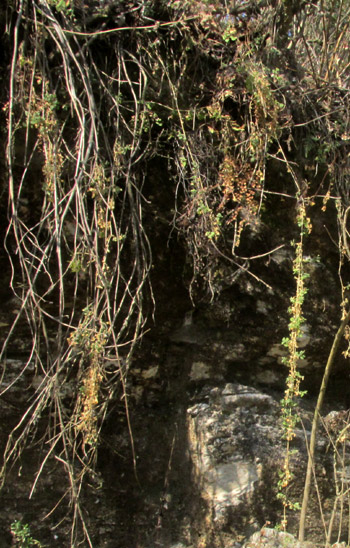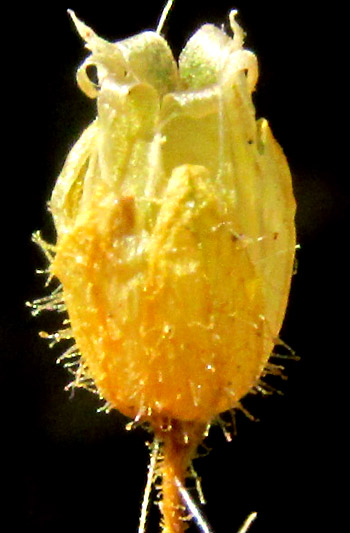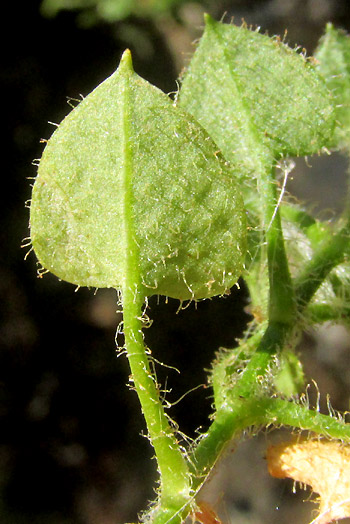Excerpts from Jim Conrad's
Naturalist Newsletter
entry from field notes dated May 6, 2023, on small gravel road descending into valley east of Curva de la Doctorcilla, which is on the road connecting Hwy120 and El Doctor; oak, pine and juniper forest on limestone bedrock; elevation ±2650m (8700 ft); Eastern Sierra Madre mountains of east-central Querétaro state, MÉXICO, (N20.88°, W99.62°)
MEXICAN CHICKWEED
 Along a narrow footpath deep in a gully shaded with tall pine trees, the little plant at the right provided a special pleasure, because of the experiences described on our Common Chickweed page. For, this just had to be another chickweed species, genus Stellaria of the Pink or Carnation Family, the Caryophyllaceae. That family's 3000 or so species are mostly Northern Hemisphere temperate-zone, mountain and alpine dwellers, which might explain why the individual at the right seems so at home, thrusting up through shed pine needles in a cool, shadowy mountain valley.
Along a narrow footpath deep in a gully shaded with tall pine trees, the little plant at the right provided a special pleasure, because of the experiences described on our Common Chickweed page. For, this just had to be another chickweed species, genus Stellaria of the Pink or Carnation Family, the Caryophyllaceae. That family's 3000 or so species are mostly Northern Hemisphere temperate-zone, mountain and alpine dwellers, which might explain why the individual at the right seems so at home, thrusting up through shed pine needles in a cool, shadowy mountain valley.
Its small, tender, herbaceous form, having two leaves attached opposite one another on the stem, and the small, white flower with five prominent, narrow, sharply pointed sepals is all classic chickweed, as is the soft-hairy stem. The Common Chickweed occurs in this area, but even at the distance from which the above photo was taken, it's clear that this is a different species, if only because the flower's white petals are much longer than the sepals. In this upland region of central Mexico known as the Bajío, three chickweed species are to be expected.

Above, the length of the white petals much exceeding the length of the subtending green sepals is all you need to notice to separate this species from the other two known to occur here. This is the Mexican Chickweed, STELLARIA CUSPIDATA, native from the mountains of southern New Mexico and Texas throughout the Mexican uplands, south through highland Central America, into the Andes of South America. By the way, though it doesn't look like, the corolla consists of only 5 white petals, but each petal is deeply cut nearly to its base, giving the appearance of two petals. Such incised petals are "pinked," as with pinking shears, and thus the name Pink Family, of which few species produce pink-colored blossoms.

The picture at the left shows the long hairs, most of which are tipped with tiny, sticky glands, which must make it awkward for small insects trying to climb up the stem to feed on leaves and flowers.
In our area it's not always as easy to distinguish this species from the other two as it is with our individual. That's because usually two subspecies of Mexican Chickweed are recognized, one with petals conspicuously longer than the sepals, the other with petals equaling or shorter than the sepals. Our plant is clearly the long-petaled one, subspecies cuspidata. If you have the short-petaled one, it can either be the short-petaled subspecies or our old friend the Common Chickweed, or the third Stellaria species found here. The short-petaled taxa are mainly recognized by their leaf shapes and sizes, which can vary in both species, making it a subtle business.
Moreover, the Flora of North America tells us that "Although they {the two subspecies} appear to be distinct in the southern United States, in Mexico where their ranges overlap, plants of uncertain identification are frequently encountered."
The 2007 study by Berenice Farfán and others entitled "Mazahua Ethnobotany and Subsistence in the Monarch Butterfly Biosphere Reserve, Mexico" reports that Mexican Chickweed in the study area is eaten as cooked greens, same as with the North's Common Chickweed. Also, of course, livestock gladly chomp on it.
Mexican Chickweed is yet another of those familiar plants first introduced to science with the collections of Humboldt and Bonpland, who in 1802 noticed it on a cold Andean mountain meadow at 4200m elevation (14,000ft). They described the habitat as "... in planitie frigid montis Antisana" -- "on the cold plain of Mt. Antisana."
Entry dated April 20, 2024, from notes taken about 1.5km northeast of Puerto de los Velazquez, Municipality of Pinal de Amoles; N21.138°, W99.665°, elevation ~2780 meters (~9120 feet); oak/pine/fir borderline cloud-forest on limestone bedrock; in the Eastern Sierra Madre Mountains of east-central Querétaro state, MÉXICO
MEXICAN CHICKWEED, DIFFERENT LOOK

At the right, at the crest of a wind- and cloudfog-swept ridge, Mexican Chickweed dangles over a limestone cliff, its slender, weak stems entangling with other dangling, woody stems.

At the left, green stems and leaves emerge from dead leaves probably killed by a recent freeze, or the ongoing dry period classified by the North American Drought Monitor as a D4 Drought, the droughtiest of their categories. The online Flora of North America describes Mexican Chickweed as an annual, while the Flora del Bajío treating chickweed species in this region says that this species is annual or, probably, perennial.

Only a few empty, capsular type fruits remained on the dangling chickweed. At the right it's seen how, to disperse seeds, the capsule opens at its tip into six segments known as valves. The calyx subtending the capsule bears conspicuous, gland bearing hairs.

Also, leaves, petioles and stems were glandular hairy, as seen at the left.